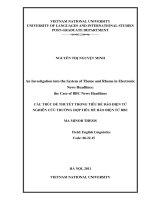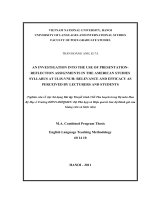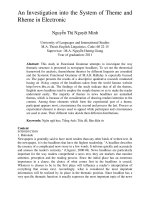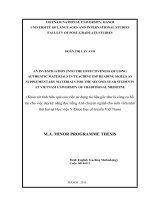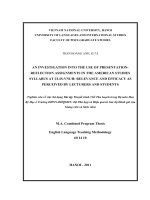AN INVESTIGATION INTO THE APPLICATION OF PROJECT BASED LEARNING IN HIGH SCHOOL ENGLISH CLASSES IN QUANG BINH PROVINCE
Bạn đang xem bản rút gọn của tài liệu. Xem và tải ngay bản đầy đủ của tài liệu tại đây (711.7 KB, 115 trang )
i
MINISTRY OF EDUCATION AND TRAINING
VINH UNIVERSITY
NGUYEN MANH CUONG
AN INVESTIGATION INTO THE APPLICATION OF
PROJECT-BASED LEARNING IN HIGH SCHOOL
ENGLISH CLASSES IN QUANG BINH PROVINCE
Major: Teaching English to Speakers of Other Languages (TESOL)
Code: 60.14.01.11
MASTER THESIS IN EDUCATION
SUPERVISOR
Tran Ba Tien, Ph.D.
Nghe An, 2017
i
STATEMENT OF ORIGINALITY
This work has not previously been submitted for a degree or diploma in
any university. To the best of my knowledge and belief, the thesis contains no
material previously published or written by another person except where due
reference is made in the thesis itself.
Nghe An, July 28th, 2017
Author’s signature
Nguyen Manh Cuong
ii
ABSTRACT
Project-Based Learning is a student-centered and directed approach,
which has been introduced in some high schools in Viet Nam for several years
and partially met student’s needs. However, how to apply Project-Based
Leaching effectively in English classes is still a challenge for administrators and
teachers. This study describes how high school teachers and students actually
perceived Project-Based Learning and how the method was applied in English
classes in Quang Binh province. The research was conducted among 20 teachers
and 60 students of two upper secondary schools. To complete this study, such
tools of data collection as survey questionnaires, classroom observation and
interviews were employed.
The findings indicate that most teachers and students were fully aware of
the necessity and benefits of Project-Based Learning in teaching and learning
English. However, some young teachers did not know how to instruct students
to carry out the project. In addition, most of the participants still faced many
difficulties when implementing the method. Basing on these findings, some
necessary solutions were suggested to make the application of PBL more
effective.
Key words: Project-Based Learning, Project-Based Teaching, studentcentered, motivation, implementing, application, pilot textbooks of English.
iii
ACKNOWLEDGEMENT
First and foremost, I would like to express my deepest gratitude to Dr.
Tran Ba Tien - my supervisor for his invaluable advice, constructive criticism,
precious correction and helpful encouragement in the completion of my
thesis.Without his valuable instructions and assistance, this paper would never
be finished.
My special thanks go to the staff of Vinh University, faculty lecturers
from Department of Foreign Languages for their providing helpful guidelines
and support in ensuring the success of my thesis.
I also express my deepest gratefulness to the leaders of Quang Binh
Department of Education and Training, the leaders and the specialists of the
Secondary Education Department for providing me with the most favorable
conditions to my further study.
Hereby, I wish to sincerely thank all the teachers and students of Foreign
Language Department at Vo Nguyen Giap Gifted High School and Ninh Chau
High School for answering the questionnaires and interviews, which are
indispensable for the analysis and discussion in my study.
I also would like to thank my beloved friends - Le Thi Kieu Oanh and
Nguyen Thi Ai Lien, who are always ready to share all my happiness and sorrow
and give me useful advice when needed.
Finally and always, my heartfelt thanks go to my family whose support is
indispensable for the fulfillment of my thesis.
iv
TABLE OF CONTENTS
Page
STATEMENT OF ORIGINALITY....................................................................i
ABSTRACT......................................................................................................ii
ACKNOWLEDGEMENT...............................................................................iii
TABLE OF CONTENTS.................................................................................iv
LIST OF ABBREVIATIONS..........................................................................vii
TABLE OF FIGURES...................................................................................viii
TABLE OF TABLES.......................................................................................ix
Chapter 1 INTRODUCTION...........................................................................1
1.1. Rationale.....................................................................................................1
1.2 Aims of the study.........................................................................................4
1.3. Significance of the study............................................................................4
1.4. Research questions.....................................................................................5
1.5. Scope of the study......................................................................................5
1.6. Design of the study.....................................................................................5
Chapter 2 THEORETICAL BACKGROUND..................................................7
2.1. Project-Based Learning..............................................................................7
2.1.1. Project.....................................................................................................7
2.1.1.1. Definitions of project............................................................................7
2.1.1.2. Types of project.....................................................................................8
2.1.2. Project-Based Learning...........................................................................9
2.1.2.1. Definitions of Project-Based Learning.................................................9
2.1.2.2. Key features of Project-Based Learning.............................................11
2.1.2.3. Benefits of Project-Based Learning....................................................13
2.1.2.4. Drawbacks of Project-Based Learning..............................................16
2.1.2.5. The procedure to do a project............................................................17
v
2.1.2.6. Roles of teachers and learners in Project-Based Learning................18
2.1.2.7. Assessment of project work................................................................23
2.2. Researches on PBL...................................................................................28
2.3. An introduction to the upper secondary pilot curriculum and textbooks. 30
2.3.1. The objectives of the upper secondary pilot curriculum and textbooks 30
2.3.2. The contents of the upper secondary set of pilot textbooks...................31
2.3.3. The structure of the upper secondary set of pilot textbooks..................33
Chapter 3 RESEARCH METHODOLOGY..................................................34
3.1. Context of Study.......................................................................................34
3.2. Participants...............................................................................................36
3.3. Data collection instruments......................................................................37
3.3.1. Questionnaires.......................................................................................37
3.3.2. Class observations.................................................................................38
3.3.3. Ethnographic in-depth interviews.........................................................38
3.4. Procedures................................................................................................39
3.5. Summary..................................................................................................39
Chapter 4 FINDINGS AND DISCUSSION...................................................41
4.1. Introduction..............................................................................................41
4.2. Teachers’ and students’ perception of Project-Based Learning................41
4.2.1. Teachers’ perception of PBL..................................................................41
4.2.2. Students’ perception of PBL..................................................................45
4.3. Teachers’ and students’ implementation of PBT and PBL.......................47
4.3.1. Teachers’ implementation of PBT..........................................................47
4.3.2. Students’ implementation of PBL..........................................................51
4.4. Teachers’ and students’ difficulties in PBT and PBL...............................53
4.4.1. Teachers’ difficulties in PBT..................................................................53
4.4.2. Students’ difficulties in PBL..................................................................55
vi
4.5. Teachers’ solutions to difficulties in PBT.................................................56
4.6. Students’ solutions to difficulties in PBL.................................................59
4.7. Discussion................................................................................................61
4.7.1. Teachers’ and students’ perception of PBL............................................62
4.7.2. Teachers’ and students’ implementation of PBL...................................62
4.7.3. Teachers’ and students’ difficulties in PBT and PBL.............................64
4.7.4. Teachers’ and students’ solutions to difficulties in PBT and PBL.........65
Chapter 5 CONCLUSION.............................................................................67
5.1. Summary of the key findings...................................................................67
5.2. Implications..............................................................................................69
5.2.1. Implications for administrators.............................................................69
5.2.2. Implications for high school teachers...................................................70
5.2.3. Implications for high school students....................................................72
5.3. Limitations of the study............................................................................72
5.4. Further research........................................................................................73
REFERENCES................................................................................................75
APPENDICES.................................................................................................80
APPENDIX 1..................................................................................................80
APPENDIX 2..................................................................................................85
APPENDIX 3..................................................................................................90
APPENDIX 4..................................................................................................92
APPENDIX 5..................................................................................................93
APPENDIX 6..................................................................................................94
APPENDIX 7..................................................................................................96
vii
LIST OF ABBREVIATIONS
DOET
MOET
PBL
PBT
VNG
Department of Education and Training
Ministry of Education and Training
Project-Based Learning
Project-Based Teaching
Võ Nguyên Giáp
viii
TABLE OF FIGURES
Page
Figure 2.1. The teachers’ roles in PBL............................................................20
Figure 2.2. The learners’ roles of learning through doing projects within the
social context...................................................................................................23
Figure 4.1. Teachers’ perception of the necessity of PBL...............................42
Figure 4.2. Teachers’ perception of the benefits of PBL.................................43
Figure 4.3. Teachers’ perception of the procedure of doing a project.............44
Figure 4.4. Students’ perception of the necessity of PBL...............................46
Figure 4.5. Students’ perception of the benefits of PBL.................................47
Figure 4.6. Teachers’ opinion about the implementation of PBT....................47
Figure 4.7. Teachers’ opinion about class organization...................................48
Figure 4.8. Teachers’ opinion about time allowed to finish the project..........49
Figure 4.9. Students’ opinion about the implementation of PBL....................51
Figure 4.10. Students’ opinion about class organization.................................52
Figure 4.11. Students’ opinion about time allowed to finish the project.........53
Figure 4.12. Teachers’ difficulties in PBT.......................................................53
Figure 4.13. Students’ difficulties in PBL.......................................................55
ix
TABLE OF TABLES
Page
Table 2.1. Themes and topics in the high school pilot curriculum.......32
Table 4.1. Result from class observation..............................................50
Table 4.2. Teachers’ solutions to difficulties in PBT............................57
Table 4.3. Students’ solutions to difficulties in PBL.............................60
1
Chapter 1. INTRODUCTION
2
1.1. Rationale
English has become an extremely popular language world-wide over a
period of many years. It is seen as a bridge that helps people from different
nations come closer to each other. Understanding its role, the Vietnamese
Government and people consider the English language as an essential means to
integrate into the world as well as to enhance the economy, education, foreign
relationships and health care system. One of the major concerns of most
educators is how to help students use English to solve the practical tasks in real
life. To catch up with this trend, the Ministry of Education and Training (MOET)
of Viet Nam claims that contemporary education needs to emphasize studentcentered teaching. This means that teachers play the roles of facilitators,
organizers, instructors, observers, and advisers who help students develop their
sense of creativity, problem-solving skills, and self-studying during the process
of learning. In doing so, students are trained key skills such as independence,
responsibility, cooperation and critical thinking.
3
To partly carry out this above issue, the Government of Vietnam has
developed a number of programs to popularize English and at the same time has
found ways to improve the quality of English language teaching and learning. In
2008, the Ministry of Education and Training, under the approval of the Prime
Minister, started the National Foreign Languages Project entitled "Teaching and
Learning Foreign Languages in the National Education System, Period 20082020”, which is aimed at making English compulsory in the school curriculum,
starting teaching English for 3rd graders, thus by the year 2020 most Vietnamese
students graduating from secondary, vocational schools, colleges and
universities will be able to use a foreign language confidently, study and work in
a multilingual and multicultural environment of integration. The resolution
covers a wide range of renovations relating to almost education activities. The
key measures consist of education management, developing teaching staff,
renovating teaching methods and renovating the curriculum and the textbook.
The renovation of the curriculum and the textbook is considered an extremely
important measure because it will lead to the change of the other educational
activities. To carry out this resolution, the pilot curriculum and a new set of
textbooks for secondary education were issued by the Ministry of Education and
Training in November, 2012 (Decision No 01/QĐ-BGDĐT and Decision No
5209/QĐ-BGDĐT). The aim of the high school pilot curriculum and textbooks
is to develop upper secondary students’ communicative competence in English.
Their skills such as listening, speaking, reading, writing will reach the third level
of the Vietnamese Foreign Language Competence Framework (equivalent to B1
in the Common European Framework of Reference for Languages) when
students finish upper secondary school.
4
Basing on the pilot curriculum, a new set of textbooks for upper
secondary students, including Tieng Anh 10, Tieng Anh 11 and Tieng Anh 12 is
dedigned. The format of these new textbooks is different from the old ones. The
most distinctive and remarkable feature in the pilot textbooks is “Project” part,
the last part of every unit, which is designed to apply Project-Based Learning
(PBL) method. The projects vary in forms, most of which are related to familiar
topics in real life so the teacher and students are able to implement them.
PBL is a student-centered and directed approach, so students can have a
chance to select the content areas and nature of the projects that they do. There
is considerable focus on students’ understanding what it is they are doing, why it
is important, and how they will be assessed. Some of the goals may actually be
set by students and they will be assessed over these goals. Learners’ motivation
and active engagement result from all of these learner-centered characteristics of
PBL. Moursund (1999) stated that a high level of intrinsic motivation and active
engagement are essential to the success of PBL methodology. Project work
makes school more like real life. It's an in-depth investigation of a real-world
topic worthy of children's attention and effort. Furthermore, a project-based
learning lesson provides students with the opportunity to learn in an authentic,
challenging and multidisciplinary environment (Moursund, 2003).
5
Although PBL has many advantages, it has just been applied at two high
schools of Quang Binh province since 2014. Being in charge of managing all the
activities of teaching and learning English in general, the application of this
method in teaching English in secondary schools, the author deeply understands
about the situation. From the factual observation, the author himself thinks that
there exist some difficulties for teachers and students. The issue may be the
result of the following reasons. Firstly, most of the current teachers of English
graduated from the universities before 2000, so they are not familiar with
project-based activities because of their regular use of traditional methods.
Moreover, most of them have not attended official training courses, so they
could not do the job effectively. At the end of each unit, all of the students in a
class are often assigned the same project, given some time to carry it out and
then asked to present the product with the help of posters or PowerPoint.
Actually, students in a class may have different levels and learners of different
classes do not always have the same purposes of learning English. Teachers
often lack time to guide and help students finish the project, while students need
teachers’ clear instructions of useful languages and the procedure to carry out
the project. As a result, it makes student unmotivated when doing the job.
Additionally, for some students’ belief, doing project is time-consuming. They
only pay attention to doing grammatical exercises and written tests which are
much more helpful for their General Certificate of Secondary Education and
Entrance University examinations.
6
For the reasons mentioned above, the author of this paper would like to
conduct this research entitled “An investigation into the application of ProjectBased Learning in high school English classes in Quang Binh province” with
the aim that this can help to identify some challenges in doing projects.
Additionally, he wishes that some suggestions will be drawn out for the teachers
who are indeed interested in PBL to apply the method effectively in English
classes.
1.2 Aims of the study
The study is conducted with the aim to investigate the perception of upper
secondary English teachers and students toward projects and Project-Based
Learning, especially the application of the method. The author also intends to
discover the challenges and difficulties the teachers and students encounter when
implementing PBL in English classes. Some suggestions would be
recommended by the researcher to help them minimize or overcome those
issues.
1.3. Significance of the study
The study is expected to be a good reference for administrators or policy
makers to manage the teaching activities better, and for teachers to implement
the method effectively in English classes. Moreover, through this study teachers
and students will become more aware of the important role of Project-Based
Learning, and be able to identify methods and specific solutions appropriate to
their learning requirements.
1.4. Research questions
In order to achieve the aims mentioned above, the study seeks the answers
to the following questions:
1. What are teachers’ and students’ perceptions of Project-Based
Learning?
7
2. How do teachers implement Project-Based Learning in their teaching?
3. Are there any problems that teachers and students encounter in
implementing Project-Based Learning?
1.5. Scope of the study
The study has been carried out among 60 10th-grade students in Vo
Nguyen Giap (VNG) Gifted High School and Ninh Chau High School, who are
using the Pilot Textbook Tieng Anh 10 as their required course book. The
students’ age group ranges from 15 to 16. They all have learned English for 8
years and their knowledge and use of English are quite good. Besides, the author
has conducted the experiment among 20 teachers of English of the two high
schools.
1.6. Design of the study
The study is divided into five sections set out in the following chapters:
Chapter 1, Introduction, introduces the rationale, aims of the study,
research questions, research scope, significance and design of the study.
Chapter 2, Theoretical Background, presents the theoretical background
of the research and issues related to Project-Based Learning applied in English
language teaching.
Chapter 3 is for Methodology in which the author describes how the
experiment was carried out. The chapter consists of the research methodology,
the context of the study, participants, data collection instruments and the
research procedure.
Chapter 4, Findings and Discussions, is reserved to reveal the findings
drawn through the analysis of both the collected data and opinions. The
discussions were conducted based on the findings.
Chapter 5 is for the Conclusion, which presents the summary of the key
findings of the research, limitations, some pedagogical implications and
suggestions for further study.
8
Chapter 2. THEORETICAL BACKGROUND
With the aim of providing a theoretical background to the study, this
chapter provides a review of issues most relevant to the topic of the research,
Project-Based Learning, and its application in English language teaching. To
help provide deeper understanding and potential insights, previous studies are
examined. The chapter is finished with an introduction to the upper secondary
set of pilot textbooks.
2.1. Project-Based Learning
2.1.1. Project
2.1.1.1. Definitions of project
When we discuss about project, there are many definitions about it.
According to Mintzberg (1983), “A project is an organizational unit that solves a
unique and complex task”. Collins (1987) shared the opinion of Mintzberg
(1983) to give another definition “A project as an idea or plan that you intend to
carry out in the future or that is being carried out at present. A project can also
be a detailed study of a particular subject”.
Although people had different ways of defining projects, they have some
characteristics in common. First, the most distinguishing feature is a specific
timeframe. All projects have time to start and finish. Second, many efforts are
called “projects” but actually become programs because they extend indefinitely
and cover broader, less specific business objectives. Third, projects must have
clear, definite goal or objective. The objective is specific, identifiable, and can
be accomplished. Finally, there are a wide range of activities in a project which
produce quantifiable deliverables that when added together, accomplish the
overall objective.
9
What is more, Thomas (2000) defined that project is complex tasks based
on problems encountered by students, conducted in certain periods of time and
culminated in realistic products that might be in form of presentation, exhibition,
and publication. The project should be long-term, require teamwork among
students and result in a substantial final product (Thompson & Beak, 2007, as
cited in Cruz & Vik, 2007). In conclusion, not every task can be considered as
project.
2.1.1.2. Types of project
People classified projects into many different types or categories. Haines
based on the ways to report the information to divide projects into 3 categories:
Production projects that include the creation of bulletin board display, video,
radio programs, posters sessions, written reports, photo essays, letters, hand
books and so on; Performance projects in the form of debates, oral presentation,
food fair, or a fashion show; Organizational projects which connected with the
planning and formation of a club, conversation table, or conversation partner
program.
Legutke and Thomas (1991) and Haines (1989) based on data collection
techniques and sources of information to classify projects into 5 categories: The
first category is Survey project that may also include displays, but more
interview, summaries, finding; The second category is Survey project which
may also include displays, but more interview, summaries, finding; The third
category is Research projects which include such kinds of work as reports,
display; Text projects which deal with “text” rather than people; The fourth
category is Encounter projects which result in face-to-face contact with guest
speakers or individuals outside the classroom and the last one is
Correspondences projects which involve communication with individual.
10
Besides, Henry (1994) also proposed three types of projects according to
the degree that the teachers and students decide on the nature and sequencing of
project-related activities. They are Structured Projects which are determined,
specified, and organized by the teacher in terms of topic, materials, methodology
and presentation; Unstructured Projects that are defined largely by students
themselves; and Semi structured projects which are defined and organised in
part by teacher and in part by students.
In summary, projects have been various classified by differently
researchers, teachers should therefore choose the most suitable format of the
project basing on the teaching context, curriculum objectives, students’ level and
interest, time constraint, materials and so on. Besides, the different types of
project should be combined to achieve the teaching goals the teacher has set.
Nevertheless, to have a correct choice, teachers must have a deep insight of
PBL, which will be discussed in the following section.
2.1.2. Project-Based Learning
2.1.2.1. Definitions of Project-Based Learning
Project-Based Learning has been differently defined by various
researchers. According to Kasíková’s study, as cited in , it takes about twenty
years for new academic concepts and insights to become commonplace in the
teaching of our public schools. This is also the case with the notion of PBL.
A project is a task that requires initiative, creativity and organizational
skills, as well as undertaking responsibility for the solution of problems
connected with the topic. It is a specific kind of a learning task, in which pupils
are allowed to choose a topic and direction of its investigation. Therefore, the
result is predictable only to a limited extent.
11
Sharing a similar view on PBL, De Jesus (2012) defined that “Projectbased learning is a dynamic approach to teaching in which students explore realworld problems and challenges, simultaneously developing cross-curriculum
skills while working in small collaborative groups”.
In PBL handbooks for teachers, projects are considered as complex tasks,
based on challenging questions or problems that involve students in design,
problem-solving, decision making, or investigating activities; give students the
opportunity to work relatively autonomously over extended periods of time; and
culminate in realistic products or presentations .
As for Fletcher (2008), Project-Based Learning is a learning method that
enables students to focus on complex problems and solve them through research.
This approach is an instructional strategy used in order to achieve success in
today’s dynamic study-fields (Gonzales & Nelson, 2005, as cited in Yalỗn et al.,
2009). They added that Project-Based Approach consists of students’ learning
knowledge, content, realities and students’ acquisition of some important skills
related to the other fields of the educational system, and their research on reallife topics.
Another author, Bell (2010), pointed out that PBL is an instructional
method centered on the learners. PBL requires students to develop a question
and are guided through research under the teacher’s supervision. Instead of
using a rigid lesson plan that directs a learner down a specific path of learning
outcomes or objectives, PBL allows in-depth investigation of a topic worth
learning more about .
12
It is clear from the above-mentioned definitions that PBL is engaging
learning experiences that involve students in complex, factual projects through
which they develop and apply skills and knowledge. The advantages can be
identified up front but sometimes are only experiences to allocate resources such
as time or materials.
In conclusion, PBL is defined in a variety of ways but they share some
primary features. Each of the definitions contains a solution to an issue by the
group of students. The result of students’ work is usually the creation of some
products including thesis, report, design plan or model. There exist commonly
many educational activities that take a considerable length of time . This paper
adopts the definitions that PBL is an authentic learning model or strategy in
which students plan, implement, and evaluate projects that have real-world
applications beyond the classroom .
2.1.2.2. Key features of Project-Based Learning
A teaching method in which students can gain knowledge and skills by
working for an extended period of time to investigate and respond to an
authentic, engaging and complex question, problem, or challenge is ProjectBased Learning. It has several key features that assist to direct the use of PBL
instruction within a classroom. The project has a real-world connection is very
important. It needs to allow students not to only make real life connections, but
also, to implement learning and apply new concepts by using their knowledge in
a variety of education contexts. The key element of PBL is working with others
is also. The core idea of PBL is that real-world problems capture the learners'
interest as they acquire knowledge. In Gold Standard PBL, Essential Project
Design Elements include the following key features:
13
Key knowledge, understanding and success skills: The project is
focused on student learning goals, including standards-based content and skills
such as critical thinking/problem solving, collaboration, and self-management.
Challenging problem or question: The project is framed by a
meaningful problem to solve or a question to answer, at the appropriate level of
challenge.
Sustained inquiry: Students engage in a rigorous, extended process of
asking questions, finding resources, and applying information.
Authenticity: The project features real-world context, tasks and tools,
quality standards, or impact - or speaks to students’ personal concerns, interests,
and issues in their lives.
Student voice and choice: Students make some decisions about the
project, including how they work and what they create.
Reflection: Students and teachers reflect on learning, the effectiveness of
their inquiry and project activities, the quality of student work, obstacles and
how to overcome them.
Critique and revision: Students give, receive, and use feedback to
improve their process and products.
Public product: Students make their project work public by explaining,
displaying and/or presenting it to people beyond the classroom.
Project work has been concerned and taken into consideration by a
number of language educators, including Carter and Thomas (1986), Ferragatti
and Carminati (1984), Fried-Booth (1982), Haines (1989), Legutke (1984,
1985), Legutke and Thiel (1983), Papandreou (1994), Ken Sheppard and
Fredricka L Stoller (1995), and Ward (1988). They share the following common
features in spite of their different perspectives of approaching:
14
► Project work focuses on content learning rather than on specific
language targets. Students’ real-world subject matter and their topics of interest
are put in the centre of the project.
► Project work is student-centered, though the teacher plays a major role
in offering support and guidance throughout the process.
► Project work supports cooperation rather than competition between
students. Students can work on their own, in small groups, or as a class to
complete a project, sharing resources, ideas, and expertise along the way.
► Project work leads to the authentic integration of skills and processing
of information from varied sources, mirroring real-life tasks.
► Project work culminates in an end product (e.g., an oral presentation, a
poster session, a bulletin board display, a report, or a stage performance) that can
be shared with others, giving the project a real purpose. The value of the project,
however, lies not just in the final product but in the process of working towards
the end point. Thus, project work has both a process and product orientation, and
provides students with opportunities to focus on fluency and accuracy at
different project-work stages.
► Project work is potentially motivating, stimulating, empowering, and
challenging. It usually results in building student confidence, self-esteem, and
autonomy as well as improving students' language skills, content learning, and
cognitive abilities.
2.1.2.3. Benefits of Project-Based Learning
15
According to Staff (2001), a wide range of benefits to both students and
teachers are further clarified from the features of PBL. A growing number of
academic researchers support the use of project-based learning in school to
engage students, cut absenteeism, boost cooperative learning skills, and improve
academic performance.
In terms of teachers, stated that additional benefits include enhanced
professionalism and collaboration among colleagues, and opportunities to build
relationships with students. Moreover, many teachers are pleased to find a model
that accommodates diverse learners by introducing a variety of learning
opportunities into the classroom. Teachers find that students for whom
traditional instructional methods are not effective can benefit the most from
project-based learning (SRI, 2000 as cited in Shiraz and Larsari (2014).
Many teachers, thinking of students’ benefits, points out that projectbased learning is an important and effective part of their teaching repertoire.
Sylvia Chard, an education researcher, has pointed out that “One of the major
advantages of project work is that it makes school more like real life. It's an indepth investigation of a real-world topic worthy of children's attention and
effort.” A project-based learning lesson provides students with the opportunity to
learn in an authentic, challenging and multidisciplinary environment (Moursund,
2003). Students can learn the way to design, carry out, and evaluate a project
that requires sustained effort over a significant period of time. Besides, learning
to work with minimal external guidance, both individually and in groups, can
help them gain in self-reliance and personal accountability. Thanks to these
opportunities, many advantages of project-based learning emerge from a
student’s point of view.
